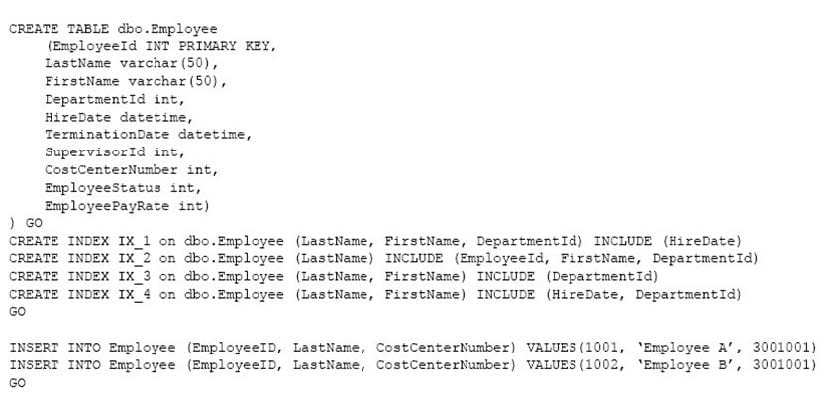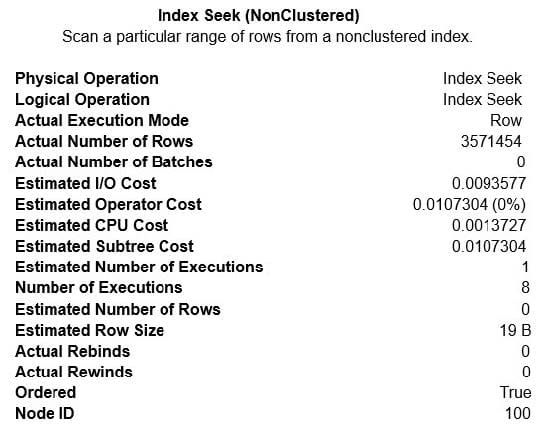Exam Details
Exam Code
:70-762Exam Name
:Developing SQL DatabasesCertification
:Microsoft CertificationsVendor
:MicrosoftTotal Questions
:182 Q&AsLast Updated
:Jan 29, 2022
Microsoft Microsoft Certifications 70-762 Questions & Answers
-
Question 61:
Note: this question is part of a series of questions that use the same or similar answer choices. An answer choice may be correct for more than one question in the series. Each question is independent of the other questions in the series.
Information and details provided in a question apply only to that question.
You are developing an application to track customer sales.
You need to create a database object that meets the following requirements:
Launch when table data is modified.
Evaluate the state a table before and after a data modification and take action based on the difference.
Prevent malicious or incorrect table data operations.
Prevent changes that violate referential integrity by cancelling the attempted data modification.
Run managed code packaged in an assembly that is created in the Microsoft.NET Framework and located into Microsoft SQL Server.
What should you create?
A. extended procedure
B. CLR procedure
C. user-defined procedure
D. DDL trigger
E. scalar-valued function
F. table-valued function
-
Question 62:
You use Microsoft SQL Server Profile to evaluate a query named Query1. The Profiler report indicates the following issues:
At each level of the query plan, a low total number of rows are processed.
The query uses many operations. This results in a high overall cost for the query.
You need to identify the information that will be useful for the optimizer.
What should you do?
A. Start a SQL Server Profiler trace for the event class Performance statistics in the Performance event category.
B. Create one Extended Events session with the sqlserver.missing_column_statistics event added.
C. Start a SQL Server Profiler trace for the event class Soft Warnings in the Errors and Warnings event category.
D. Create one Extended Events session with the sqlserver.error_reported event added.
-
Question 63:
Background
You have a database named HR1 that includes a table named Employee.
You have several read-only, historical reports that contain regularly changing totals. The reports use multiple queries to estimate payroll expenses. The queries run concurrently. Users report that the payroll estimate reports do not always run. You must monitor the database to identify issues that prevent the reports from running.
You plan to deploy the application to a database server that supports other applications. You must minimize the amount of storage that the database requires.
Employee Table
You use the following Transact-SQL statements to create, configure, and populate the Employee table:

Application
You have an application that updates the Employees table. The application calls the following stored procedures simultaneously and asynchronously:
UspA: This stored procedure updates only the EmployeeStatus column.
UspB: This stored procedure updates only the EmployeePayRate column.
The application uses views to control access to data. Views must meet the following requirements:
Allow user access to all columns in the tables that the view accesses.
Restrict updates to only the rows that the view returns.
Exhibit

You are analyzing the performance of the database environment. You discover that locks that are held for a long period of time as the reports are generated.
You need to generate the reports more quickly. The database must not use additional resources.
What should you do?
A. Update all FROM clauses of the DML statements to use the IGNORE_CONSTRAINTS table hint.
B. Modify the report queries to use the UNION statement to combine the results of two or more queries.
C. Apply a nonclustered index to all tables used in the report queries.
D. Update the transaction level of the report query session to READ UNCOMMITTED.
-
Question 64:
Note: This question is part of a series of questions that present the same scenario. Each question in the series contains a unique solution that might meet the stated goals. Some questions sets might have more than one correct solution,
while others might not have a correct solution.
After you answer a question in this section, you will NOT be able to return to it. As a result, these questions will not appear in the review screen.
You have a database that is 130 GB and contains 500 million rows of data.
Granular transactions and mass batch data imports change the database frequently throughout the day. Microsoft SQL Server Reporting Services (SSRS) uses the database to generate various reports by using several filters.
You discover that some reports time out before they complete.
You need to reduce the likelihood that the reports will time out.
Solution: You increase the number of log files for the database. You store the log files across multiple disks.
Does this meet the goal?
A. Yes
B. No
-
Question 65:
Note: This question is part of a series of questions that use the same scenario. For your convenience, the scenario is repeated in each question. Each question presents a different goal and answer choices, but the text of the scenario is exactly the same in each question in this series.
You have a database that contains the following tables: BlogCategory, BlogEntry, ProductReview, Product, and SalesPerson. The tables were created using the following Transact SQL statements:

You must modify the ProductReview Table to meet the following requirements:
The table must reference the ProductID column in the Product table
Existing records in the ProductReview table must not be validated with the Product table.
Deleting records in the Product table must not be allowed if records are referenced by the ProductReview table.
Changes to records in the Product table must propagate to the ProductReview table.
You also have the following database tables: Order, ProductTypes, and SalesHistory. The transact-SQL statements for these tables are not available.
You must modify the Orders table to meet the following requirements:
Create new rows in the table without granting INSERT permissions to the table.
Notify the sales person who places an order whether or not the order was completed.
You must add the following constraints to the SalesHistory table:
a constraint on the SaleID column that allows the field to be used as a record identifier
a constant that uses the ProductID column to reference the Product column of the ProductTypes table
a constraint on the CategoryID column that allows one row with a null value in the column
a constraint that limits the SalePrice column to values greater than four
Finance department users must be able to retrieve data from the SalesHistory table for sales persons where the value of the SalesYTD column is above a certain threshold.
You plan to create a memory-optimized table named SalesOrder. The table must meet the following requirements:
The table must hold 10 million unique sales orders.
The table must use checkpoints to minimize I/O operations and must not use transaction logging.
Data loss is acceptable.
Performance for queries against the SalesOrder table that use WHERE clauses with exact equality operations must be optimized.
You need to modify the environment to meet the requirements for the Orders table.
What should you create?
A. an AFTER UPDATE trigger
B. a user-defined function
C. a stored procedure with output parameters
D. an INSTEAD OF INSERT trigger
-
Question 66:
Note: This question is part of a series of questions that present the same scenario. Each question in the series contains a unique solution. Determine whether the solution meets the stated goals. You have a table that has a clustered index and a nonclustered index. The indexes use different columns from the table. You have a query named Query1 that uses the nonclustered index. Users report that Query1 takes a long time to report results. You run Query1 and review the following statistics for an index seek operation:

You need to resolve the performance issue. Solution: You rebuild the clustered index. Does the solution meet the goal?
A. Yes
B. No
-
Question 67:
You need to create a view that can be indexed. You write the following statement.

What should you add at line 02?
A. with check_option
B. with recompile
C. with view_metadata
D. with schemabinding
-
Question 68:
You have a nonpartitioned table that has a single dimension. The table is named dim.Products.Projections.
The table is queried frequently by several line-of-business applications. The data is updated frequently throughout the day by two processes.
Users report that when they query data from dim.Products.Projections, the responses are slower than expected. The issue occurs when a large number of rows are being updated.
You need to prevent the updates from slowing down the queries.
What should you do?
A. Use the NOLOCK option.
B. Execute the DBCC UPDATEUSAGE statement.
C. Use the max worker threads option.
D. Use a table-valued parameter.
E. Set SET ALLOW_SNAPSHOT_ISOLATION to ON.
-
Question 69:
Your company runs end-of-the-month accounting reports. While the reports run, other financial records are updated in the database.
Users report that the reports take longer than expected to run.
You need to reduce the amount of time it takes for the reports to run. The reports must show committed data only.
What should you do?
A. Use the NOLOCK option.
B. Execute the DBCC UPDATEUSAGE statement.
C. Use the max worker threads option.
D. Use a table-valued parameter.
E. Set SET ALLOW_SNAPSHOT_ISOLATION to ON.
F. Set SET XACT_ABORT to ON.
G. Execute the ALTER TABLE T1 SET (LOCK_ESCALATION = AUTO); statement.
H. Use the OUTPUT parameters.
-
Question 70:
You have several real-time applications that constantly update data in a database. The applications run more than 400 transactions per second that insert and update new metrics from sensors.
A new web dashboard is released to present the data from the sensors. Engineers report that the applications take longer than expected to commit updates.
You need to change the dashboard queries to improve concurrency and to support reading uncommitted data.
What should you do?
A. Use the NOLOCK option.
B. Execute the DBCC UPDATEUSAGE statement.
C. Use the max worker threads option.
D. Use a table-valued parameter.
E. Set SET ALLOW_SNAPSHOT_ISOLATION to ON.
F. Set SET XACT_ABORT to ON.
G. Execute the ALTER TABLE T1 SET (LOCK_ESCALATION = AUTO); statement.
H. Use the OUTPUT parameters.
Related Exams:
62-193
Technology Literacy for Educators70-243
Administering and Deploying System Center 2012 Configuration Manager70-355
Universal Windows Platform – App Data, Services, and Coding Patterns77-420
Excel 201377-427
Excel 2013 Expert Part One77-725
Word 2016 Core Document Creation, Collaboration and Communication77-726
Word 2016 Expert Creating Documents for Effective Communication77-727
Excel 2016 Core Data Analysis, Manipulation, and Presentation77-728
Excel 2016 Expert: Interpreting Data for Insights77-731
Outlook 2016 Core Communication, Collaboration and Email Skills
Tips on How to Prepare for the Exams
Nowadays, the certification exams become more and more important and required by more and more enterprises when applying for a job. But how to prepare for the exam effectively? How to prepare for the exam in a short time with less efforts? How to get a ideal result and how to find the most reliable resources? Here on Vcedump.com, you will find all the answers. Vcedump.com provide not only Microsoft exam questions, answers and explanations but also complete assistance on your exam preparation and certification application. If you are confused on your 70-762 exam preparations and Microsoft certification application, do not hesitate to visit our Vcedump.com to find your solutions here.